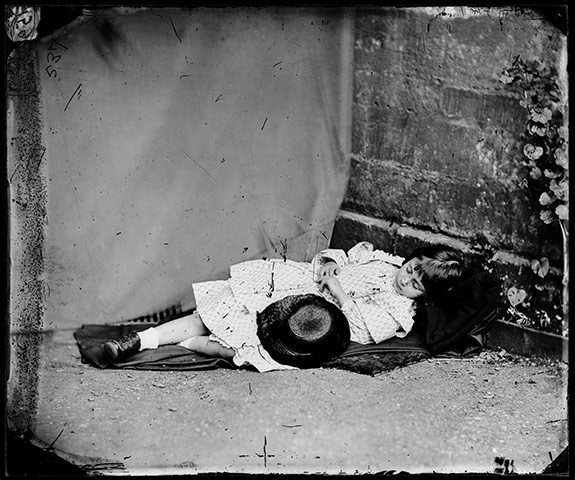
The character of Alice was based on Alice Pleasance Liddell, daughter of the dean of Christ Church, Oxford, whom Dodgson met when he was a lecturer there. Dodgson took a number of photographs of the Liddell sisters, including the real Alice, from the age of four to the last at the age of 18 – this is one of the most famous
Photograph: National Portrait Gallery London Photograph: Action images

Dodgson made up the stories about Alice to keep the Liddell girls entertained during the long exposures of his photographs Photograph: National Portrait Gallery

Dodgson presented Alice with the handwritten manuscript of Alice's Adventures Underground, complete with his own illustrations, in 1864. An extended version, Alice's Adventures in Wonderland, was published the following year, but he later wrote to Alice, 'I think, considering the extraordinary popularity the books have had (we have sold more than 120,000 of the two) there must be many who would like to see the original form' Photograph: The Governing Body of Christ Church, Oxford

This page is from the original manuscript that Dodgson presented to Alice Photograph: Laurence Pordes/The British Library

Dodgson (Carroll) was never convinced by his own abilities as a draughtsman, and in the first published version of the manuscript he asked John Tenniel, a well-known illustrator and caricaturist, to redo his original drawings. Tenniel's illustrations became world famous, and his is the Alice most people think of today Photograph: Rosenbach Museum & Library, Philadelphia

Another preliminary sketch by John Tenniel of a classic Alice moment, when she consumes a cake inscribed with 'EAT ME' that causes her to grow to such a huge size her head hits the ceiling Photograph: Rosenbach Museum & Library, Philadelphia

Ernst was the surrealist artist who engaged most with the works of Lewis Carroll, producing numerous works that directly allude to Alice between 1939 and 1970. A prisoner of war in France in 1939, many relate closely to his experience of war, escape and the hope of protection in a distant land Photograph: The Museum of Modern Art, New York/Scala, Florence

In the 1960s, 'chasing the white rabbit' was used to describe taking hallucinogenic drugs, linking the altered state of consciousness of LSD trips with Alice's emergence in a strangely altered world. Alice became the poster-child for the psychedelic generation Photograph: Private Collection, Italy

In 1969, Dalí made 12 illustrations for Alice's Adventures in Wonderland, one for each chapter. Alice is shown as a girl with a skipping rope, a motif that had appeared frequently in Dalí's work since 1936 Photograph: Fundacio Gala-Salvador Dali, DACS 2011

One of Blake's classic graphic illustrations of Through the Looking Glass Photograph: Tate / Peter Blake All rights reserved, DACS 2011

Not one for the kids: Woodman's rabbit-headed man stands to attention
Photograph: The Estate of Francesca Woodman, Courtesy George and Betty Woodman/Victoria Miro Photograph: Francesca Woodman/The Estate of Francesca Woodman/Courtesy George and Betty Woodman/Victoria Miro

Alice's Adventures in Wonderland has often been interpreted as a coming-of-age story, told from the perspective of a young girl trying to get her bearings in the world. Gaskell's Wonder series captures the uncanny nature of childhood by using unusual perspectives like this Photograph: Courtesy of Yvon Lambert Gallery

Rather than calling on the better-known Tenniel illustrations, Smith reworks Dodgson's original drawings, particularly those that resonate with her interest in girls as literary figures, or the common fairytale links between animals and people Photograph: Courtesy of ULAE, inc

Bezalel's drawings feature reworkings of Tenniel's Alice, disconnected from the stories and placed in alternative landscapes. Her interest in Alice is focused on the fall down the rabbit hole, a place of limbo where 'nothing' has an almost tangible form Photograph: Studio Girardet

